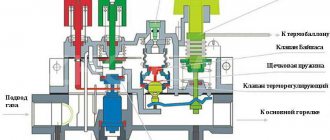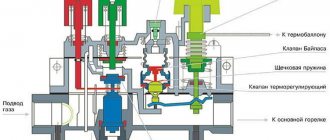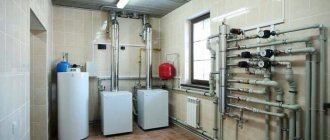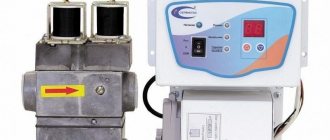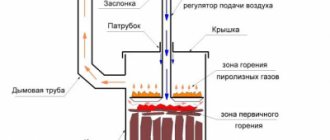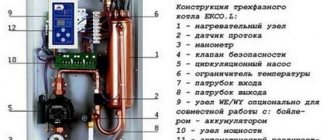Features and Properties
GSM heating boiler control has the following capabilities:
- ensure the required temperature regime in the house at any time of the year, and there is no need to be close to the boiler to change the temperature;
- from a distance, prepare the house for the arrival of the owners, setting a comfortable temperature there (even if the building has been empty for several weeks, its owners and guests will not have to return to the cold room);
- in winter, prevent freezing of pipes and their subsequent depressurization during unexpected frosts - you can increase the temperature in the boiler while away from home by simply sending a message;
Boiler control via GSM - the possibility of optimal fuel consumption - provide remote monitoring of the serviceability of the installed heating system - messages are sent in case of failures;
- heating operation in the shortest possible time in case of emergencies;
- ensure maximum fuel economy;
- increase the operating time of a gas boiler - due to timely response to emergency situations.
That is, GSM heating control by phone or via the Internet provides a previously inaccessible level of comfort in a country house or in a private home. This device is useful for those whose work involves frequent absences, who are often away, and have no one to constantly monitor the heating condition.
Thermostat.
This device, due to the air temperature sensor installed in it (optional - heated floor or other sensor), monitors the ambient temperature readings and maintains the necessary microclimate in the house or a separate room. The user simply adjusts the required temperature value on the thermostat. Basically, thermostats are divided into two types - mechanical or electronic. According to the method of signal transmission, they can be: wired, wireless, controlled via wifi, internet and gsm. With the help of these regulators, installing them in each room in the building, you can create the so-called “zone control”.
Features of remote control
Controlling heating in a country house via GSM or via the Internet will be appreciated by owners of country houses or summer cottages designed for year-round use. If you have to leave the house unattended for a long time, concerns arise about the functioning of the heating system - for example, if the boiler goes out for some reason and does not turn on automatically, the system will freeze. This is fraught with depressurization of the circuit and the need to seriously invest in repairs.
Remote heating control has a number of advantages
:
- due to operation in an economical mode, energy costs are reduced and the life of the equipment is extended, since it wears out less under reduced loads;
- the heating system can be included in the general network of the house, created for engineering systems - this will reduce the total costs of their operation.
Boiler control, both via GSM (SMS) and via the Internet, makes it possible
:
- monitor the maintenance of the standard operating mode of the autonomous heating system with uniform heating of the entire house;
- if necessary, provide selective heating of rooms in accordance with personal preferences;
- prevent freezing of the heating system pipeline during a long absence of owners in the cold months;
- switch the heating system from economy mode to standard mode in advance so that the cottage or country house is warmed up when the owners arrive;
- monitor the condition and functioning of the heating system online and promptly receive information about problems.
Screenshot from the personal account of a GSM heating control controller.
An autonomous heating control system can be the first step towards creating a “smart home” and providing the most comfortable living conditions.
Which systems can be controlled remotely?
Automatic heating control is used for two-pipe autonomous systems with a membrane expansion tank and a pump for forced supply of coolant into the circuit. It is especially effective to control a system where each heating device is connected separately, through a distribution comb - a manifold. The system may include circuits with radiators and warm water floors.
The system is necessarily equipped with a safety unit, which operates automatically and prevents depressurization of the boiler water jacket and heating circuit due to excess pressure. Excess pressure is released through the emergency valve.
Additionally, equipment is installed that allows you to control the system - temperature and pressure sensors, devices that allow you to regulate coolant flow, controllers, and tools for creating a unified information network.
Weather-compensating system
Controlling a heating boiler is more effective if, in addition to temperature sensors installed in heated rooms, a device for measuring outdoor air temperature is added. This option provides precise temperature control and makes it possible to configure the system so that it independently adapts to changing weather conditions.
As a result, when it gets colder, the radiators will heat up more, and when it gets warmer, they will switch to energy-saving mode. This not only helps save energy, but also reduces the inertia of the heating system.
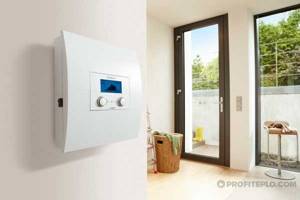
Wall-mounted weather-compensated heating controller for heating system control
Flexible zone control ensures a comfortable environment for people depending on the situation: for example, if there are many people in a room, it quickly becomes hot as bodies radiate heat. The temperature sensor in the room reacts to an increase in air temperature, as a result of which the heating of the radiators in this room is reduced to an optimal level.
Typically, a weather-compensated system is configured to automatically turn off the boiler if the outside temperature reaches a preset level. Wireless and remote control systems are ideally combined with weather-sensitive automation - the operation of the system does not require constant human intervention; it is enough to make adjustments to the operating mode as needed.
The best known manufacturers and models: characteristics and prices
"Kotel OK"

The most popular on the market, one of the best and most inexpensive GSM modules for heating boilers made in Russia. In addition to the price, it is distinguished by its compact size, extremely simple and easy setup, and the presence of an application that can send commands, including in the form of SMS, which is an excellent option that allows you not to use tariffs with Internet access.
The functionality of the device is quite simple, the minimum required: temperature control, setting alerts, checking boiler operating parameters, and the module also has a built-in relay that allows you to turn the boiler on and off.
Among the disadvantages, it is worth noting a rather simple application with the minimum required functionality and an outdated interface, the presence of an external temperature sensor with a cable length of only 0.5 meters, which does not imply its installation in other rooms remote from the boiler room. The antenna is also not remote, screwed into the device via a threaded connection.
XITAL GSM 4T

Another well-known, more professional and versatile device with a much richer package. The heating control functionality in it is approximately the same as in the previous “Boiler OK” - the minimum required, however, there are as many as 4 zones for additional devices (flow sensor, smoke sensor, motion sensor, flood sensor, door opening sensor, etc.). Also included is an electronic key and a reader (similar to those installed in intercoms), so you can influence the settings, if desired, only with an electronic key.
The main difference is the presence in the kit of two remote temperature sensors with a wire length of 10 m, as well as a remote wired antenna and a cord for connecting a backup external battery (unfortunately, there is no built-in one). Management and control can be carried out both via SMS and through the application.
The disadvantages, in addition to the lack of a built-in battery, are the ineffective and inconvenient, although understandable, application interface, less attractive appearance with exposed terminals and large dimensions. Please note that for heating you must choose a model that has a “T” at the end.
In what cases is a voltage stabilizer for a gas boiler indispensable and how to choose it?
EVAN GSM CLIMATE
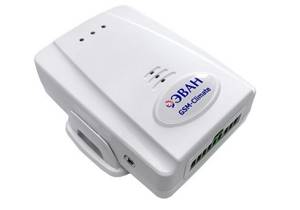
Also known as ZONT H-1, it features a more modern and convenient application, with ready-made “Economy” and “Comfort” modes, as well as the ability to program boiler operating parameters. It is enough to configure the boiler operating pattern once and the module will automatically issue commands to the boiler to change parameters depending on the time or day of the week. Control via a web interface is also available. The standard package includes one remote temperature sensor and a remote antenna.
Perhaps the only drawbacks are the lack of a built-in battery and only one contact for connecting an external temperature sensor.
ZONT H-1V
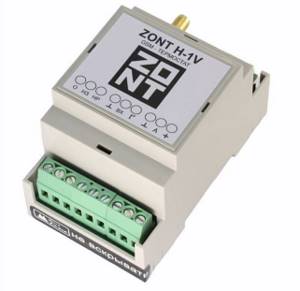
A more advanced analogue of the previous GSM CLIMATE (ZONT H-1). Despite its less attractive appearance, it has an additional “Anti-Freeze” mode and a built-in battery for autonomous operation during power outages. Number of connected temperature sensors – up to 10 pcs.
Otherwise, due to the same firmware, everything is similar to the previous model: the same control via SMS, application or web interface, which, by the way, is one of the most convenient and functional, with statistics. The kit still includes one remote temperature sensor and a remote wired antenna.
How to choose a GSM module for a boiler
When choosing a notification module, it is important to pay attention to its functionality and technical characteristics:
- Control – settings are made using buttons on the touch panel and SMS commands sent from the phone. Programmers from leading manufacturers are controlled by special software. The companies Viessmann and Buderus produce programs for Android and iOS that allow you to quickly remotely access the boiler.
Equipment - depending on the selected model, the module is equipped with an automatic gas control system and remote room temperature sensors.
Number of control channels – this parameter determines how many temperature sensors and other equipment can be connected simultaneously. Standard models have two channels, one is used to connect a remote programmer for remote control of a gas boiler via GSM, the second is used to transmit signals via SMS messages.
Microprocessor - budget models of control units, have only a few simple functions and fixed operating modes. Premium class equipment, has a built-in weekly programmer for controlling the temperature of the gas boiler using GSM.
Battery – the control unit operates from the mains. In the event of a power failure, power is automatically switched to the battery. The battery capacity should be sufficient to ensure autonomous operation of the module for several hours. If power outages occur frequently, choose a battery with a larger capacity.
When choosing a module, they are guided by the recommendations of gas equipment manufacturers.
Cost of GSM remote control for boilers
A gas heating boiler with a GSM remote control module consumes up to 30% less gas. The initial costs of installing a remote controller will pay off within the first heating season. The cost of the remote control, depending on the chosen model and configuration, varies from 5-12 thousand rubles.
Some manufacturers of gas equipment offer consumers boilers with a built-in GSM control unit. In this case, you will need to buy remote room thermostats and configure them to operate the module.
How to install a GSM module on a boiler
It is not difficult to organize control over the operation of the boiler yourself. To do this you will need to do the following:
- Using special connectors, connect the control unit to the boiler controller.
Insert the SIM card into the slot. To prevent third-party users from connecting, set a PIN code.
Enter all phone numbers to which alerts will be sent.
After completing all the manipulations, a verification code is sent from the phone, and in response you will receive a message about the operating parameters of the boiler. The information received will show that the unit is connected.
It is recommended that the installation of the remote control and GSM unit be carried out by qualified specialists - electrical engineers. Independent work is carried out at your own peril and risk, and is the reason for refusal of warranty service.
Design and principle of operation
The gas boiler is controlled via GSM using a small-sized GSM module. Of value are universal devices that can interact with several models of units, for example, the domestic Telemetrics module is capable of functioning with a dozen boiler units of Russian and Western production. The module organizes the transfer of data on the performance of the unit and thermal conditions in the house using SMS messages or through software applications.

The GSM agent performs remote control of the boiler operating modes, so the house will be heated with a preset internal air temperature when the residents arrive, and in their absence, the rooms will be heated in standby mode. The advantage of such control is that it is implemented by one responsible person, using constant access to the current operating parameters of the heat supply system.

The installation of a GSM thermostat is capable of taking over control of the thermal processes of the boiler, and user access to it is possible from any region of the planet equipped with mobile communications. Modern gas boilers are a complex of complex interconnected systems; incorrect regulation of even one parameter will cause an emergency when operating expensive equipment.
Modern units are produced non-volatile. Even if the owner receives a signal that the power or water is turned off in the house, he will be able to quickly respond online to prevent accidents.
Basic automation functions
The main purpose of automation in heating systems is an instant response to changing situations. One of the main tasks of automatic control devices is to stop the supply of gas to the work area. Situations in which it may be necessary to cut off the supply of household gas may be the following:
- poor operation of the exhaust device, deterioration of draft, in which there is a high probability of harmful combustion products entering the interior;
- sudden changes in operating pressure in the main gas pipeline;
- unauthorized flame extinguishing on the main burner.
In these situations, it is thanks to the automation of the gas boiler that the supply of gas fuel is controlled, which ensures the safety of residents. It is for safety reasons that, in accordance with existing standards, it is necessary to equip all old models of gas heating equipment with automatic systems, the standard equipment of which did not include equipping with these devices. As for the latest gas heating units, these are boilers with automation.
Main article: DIY gas burner.
Connecting automation to a solid fuel boiler
The installation process begins with a fan, which is installed on the air supply door or ash pan. Many modern solid fuel models already have places and holes for mounting the supercharger. Otherwise, you need to drill the holes yourself and secure the boost fan with four bolts.
Please note the presence of a heat-resistant gasket: it is required, but not available on all fan models. As a result, the turbine should be installed in accordance with the photo below.
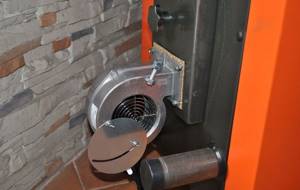
Properly installed boost fan.
The second step is the installation and connection of the automation itself to the solid fuel boiler. The controller is installed on top or on the side of the case through the device holes intended for this purpose. Despite the fact that the body of many controllers is made of heat-resistant materials, it is advisable to install the device on the coldest part of the boiler body, if necessary, placing a heat-resistant gasket made of non-flammable material.
All that remains is to connect all the elements and connect the controller to the power supply. A detailed connection diagram is always indicated in the automation instructions, for example, this is what the connection diagram to the Komfort ECO control unit looks like:
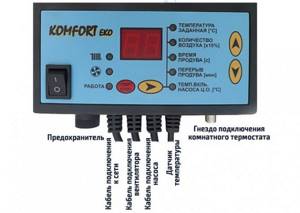
Automation connection diagram using Komfort ECO as an example.
How to set up
The detailed setup algorithm also depends on the model and is always described in the instructions. In general terms, the setup implies the following procedure:
- Setting the temperature for turning on the circulation pump - allows you to turn on the pump not immediately, but when the coolant has already warmed up, it is necessary to prevent the formation of condensation (usually set to 50°C).
- Setting the desired temperature of the heating circuit or room air, depending on the model and controls.
- Setting the fan rotation speed (from 1 to 10) or selecting one of the automatic fan speed control modes. When setting the boost completely manually, you also need to set the parameters for the fan operating time and the frequency of its activation in combustion support mode.
- Adding fuel and igniting the boiler. Monitoring its operation and, if necessary, adjusting parameters.
In some models, you can also program operation for a day or a week in advance, set a temperature threshold, after which the fan will begin to gradually reduce speed, etc.
InstructionsBoilersSolid fuel boilers
Popular models according to user ratings

The availability of a convenient option has created the preconditions for creating demand for new equipment that can solve many problems. The offer was not long in coming and many companies appeared on the market offering their equipment for sale. The following manufacturers received the greatest fame due to high consumer ratings:
- Vaillant;
- Wisman;
- Buderus;
- Protherm;
- Navien;
- Kiturami;
- Evan;
- Xital.
The list of VIESSMANN products includes heat generators in which adapted units are installed that can interact with boiler control controllers. Also different is the equipment, which is equipped with the latest algorithms that increase the reliability of cascade control.
Plus, the devices of this company are designed to duplicate the system using an additional network; they have the ability to install an additional SIM card.
Elements of a gas boiler control circuit
The electrical circuit of a gas boiler includes blocks of electronic boards and their radio elements. You can consider an example of a diagram of a typical Ariston UNO 24MFFI unit, which displays the location of the boiler elements.

A – temperature regulator.
A11 – flame sensor.
B – button that allows you to clear the error and reboot the device (Reset).
C – on/off (Power).
D – switch to “Comfort” mode.
E – hot water temperature regulator.
F, G, H, I – LEDs that indicate faults or certain operating modes.
J – connector for connecting a thermostat.
K – pump power supply relay.
L – three-way valve power relay.
M – fan control relay.
N – gas valve relay.
O – remote control control connector.
P, Q, R, S – jumpers responsible for sparking, ignition, temperature selection and smooth ignition with maximum power.
T – two-wire connector for external thermostat and control of the set temperature.
U – power supply of the electronic circuit.
Connection CN301 terminal block, to which the gas valve, circulation pump, transformer and three-way valve actuator are connected.
The CN201 connector is connected to supply and return water temperature sensors, a chimney sensor, and a water flow sensor.
Connector CN102 in position A is responsible for setting the ignition power of the burner device. During the setup process, the red sensor will blink.
Jumper CN101 on A turns off the ignition delay, in position B it turns on the delay by 2 minutes.
CN104 – sets operation in different temperature ranges: A – 35-45ºC, B – 43-82ºC.
CN100 is responsible for setting the maximum power of the unit.
Advantages and disadvantages of GSM devices
This is what the client will receive by connecting the GSM module:
Safety. The main purpose of the GSM module is to control the heating system and additional equipment, timely informing about existing or possible breakdowns. By connecting, for example, an additional broken glass sensor, you can quickly react if thieves break into your house.
Comfort. Management of key indicators of heating and related systems without the physical presence of the consumer next to them. For example, when returning home, you can easily preheat the water in the boiler to the required levels or increase the temperature in the entire house by sending one message.
Saving. When no one is home, the temperature can be as low as possible, and you will thus reduce your heat bill by a significant amount. And the absence of constant load on the heating system will help extend the life of the boiler, boiler and other equipment.
The diagram shows all the benefits of the module that its owner receives. They are implemented through proper device settings and correct connection
Thanks to these three advantages, the commercial attractiveness of the module is formed.
And GSM equipment also has its drawbacks. Fundamental, of course, is the high price of the device. Users note the need to constantly monitor the cash balance of cellular communications, dependence on the operator’s work and coverage (which is especially inconvenient for owners of houses outside the city or in villages remote from metropolitan areas). Also inconvenient is the complexity of connecting yourself and the additional costs of installation.
Options for organizing a heating control system. Smart technologies in every home
This is an electrical device, the purpose of which is to adjust the parameters of connected devices, adjusting their operation. Controllers are used in heating systems to control the fuel supply in boilers. KO is a block with several elements. Their purpose is to allow the owner to manually adjust the boiler temperature. The controller is configured to automatically process data received from thermometers. Programming the device requires software skills, but allows you to build a heating system that saves fuel.
With the help of KO, not only the classic piping is adjusted, but also warm floors and other climate regulators. Photo 3. The Thermomatic heating controller is necessary to control the fuel supply in boilers.
Automatic control unit
The main disadvantage of KO is the need for long programming for full automation. To create control, you will need to spend a large amount on installing controllers and sensors.

They will also have to be included in the system, which is not difficult, but labor-intensive. This is followed by setting up the devices and establishing the principles of operation.
Would you like to come to an already warm country house in winter? How nice it would be to arrive to a warm house, and not have to wait for the heating devices to heat the house to a comfortable temperature. This issue can be solved by a GSM electrical equipment control system. This results in significant savings on heating costs. Controlling heating via SMS or mobile application at any time and at any distance is now becoming especially popular.
Some automated Smart Homes include heating controls. It can be standard, with separately connected devices, or centralized, in which commands are issued to the entire system. The latter is preferable because it reduces the amount of resources spent on work. For full operation of control devices, it is necessary to install two types of sensors. The first ones are placed in a heated room, the second ones - on the street.
By combining the readings, the system better manages fuel consumption, which leads to savings on automation operation.
Application for heating calculation "KOUZI"
Installing the system can significantly reduce utility bills. The devices turn off the heating of the room if it is not needed. This reduces resource costs, which over time will lead to lower heating costs. An online magazine about barbecues, ovens, grills, barbecues and other garden and home cooking equipment.
Remote heating control system "GALAN-GSM" from.
GALAN- GSM GALAN -GSM
• Ability to control the boiler on/off and the NAVIGATOR
«.
• Temperature control of the heating system based on room temperature with a built-in sensor.
• Adjusting the temperature of the heating system based on the temperature of one of the remote temperature sensors.
• Accuracy of temperature control according to the set value with hysteresis +-1 deg. Celsius.
• Warning when the heating system temperature is exceeded.
• Indication of loss/appearance of mains voltage.
• Control of two independent devices (three relays with changeover contact).
• Organization of a security system with electronic, programmable keys.
• Connecting an external microphone. (Room listening)
• Connecting glass break sensors, motion sensors, door opening sensors. (up to 4 zones)
• Ability to view the temperature of up to 5 rooms, and also choose which sensor to use to regulate the temperature of the heating system.
• Availability of a siren activation relay.
Impressive functionality isn't it? You can organize control not only of the temperature of the heating system, but also of turning on, say, the lights in the house in the evening, the water heater or other devices, for example, a spotlight when approaching the dacha. And the integrated simple security functionality will allow you to be aware that everything is fine at home.
Expert advice: how to protect yourself from controller breakdowns
Repair of control units for gas boilers is not a common occurrence. However, before purchasing equipment from a certain manufacturer, ask if there are service centers in your region.
To protect yourself from troubles at the wrong time, you should, with the help of specialists, inspect the boiler before and after the heating season. A network voltage stabilizer will help protect the electrical controller from pressure surges, thereby protecting the device from damage.
You can prevent possible damage to the control unit the first time it is put into operation. The unit system is complex and fragile in its own way; settings may be lost during transportation or assembly of the equipment. Therefore, during installation, they first carefully check all the subtleties associated with the wiring, water and gas supply, and then check the operation of the CU sensors.
The latest models of controllers have been brought to almost complete independence. The gas boiler control unit reports faults using indicators, as can be seen in the diagram below.

If you notice any failure, even a minor one, it is better to immediately call a boiler service specialist, this will prevent a serious breakdown and save yourself from more serious problems.
Heating appliances are often the subject of experiments, which result in towel dryers for example. At a technology competition in 2007 in the United States, among the various designs one could see a radiator in the form of a rack of hangers, designed in the shape of a chair with a heated seat.
Modern home heating equipment is as convenient as possible for users. Having set the necessary parameters for the device, you do not need to constantly monitor its operation, relying on the automatic mode. And timely diagnostics of heating devices will allow you to avoid troubles due to incorrect operation or breakdowns.
An example of installing the controller can be found in the video:
Basic operating principle
The main detail in the entire scheme is the electronic control unit, which provides slots for installing standard SIM-format cellular communication cards. More technological modifications also have a connector where an electronic Internet cable is connected. Likewise, temperature sensors, pressure indicators, fire alarms and other security systems are connected to this module. Of course, to provide feedback, the unit itself must be connected to the heating boiler.
The heating of a country house is controlled according to a generally simple scheme. The initial operation setup is carried out, after which the central processor records the correct operating conditions of the system in memory. If one of the connected sensors sends a signal about a change in these conditions, for example, the temperature begins to decrease, a text message is sent to the owner’s cell phone. The owner, in turn, can request readings from other sensors in order to more fully assess the situation, send a response command by text message to turn off the devices or continue working as usual.
Advantages of remote control systems
First, you need to determine the method of future remote control of the heating boiler by choosing one of two options. In the first case, the boiler is controlled via the Internet, for which you must have an Internet connection. In the second case, this mission is performed by cellular communications, which is more suitable for a home located at a distance from city communications.
Internet control
If you install remote control of a gas boiler using the Internet, you can get a series of additional benefits.
After installing the necessary control elements into the heating system, the following options open up:
- remote control of various functions of the heating boiler, including operating modes of the circulation pump;
- by installing the required number of sensors, you can determine different temperature conditions for several zones;
- remote coordination of hot water supply, in case of installing a double-circuit boiler;
- 24-hour monitoring of the current state of the operating heating system;
- the most economical fuel consumption, because during a long absence there is no need to maintain the usual microclimate.
The indicated advantages constitute only a basic set of possibilities provided for an individual heating system. If desired, control over the internal temperature of the house can be taken to the next level by using a more versatile version that uses an Internet gateway and an automated heating control unit.
In this case, it will be possible to additionally control heating elements, oil radiators or electric convectors. Among other things, the list of systems for remote control of the boiler may include a fire alarm, which will not be superfluous if the house is built of wood.
Cellular control
An alternative to the control unit for the heating system of a country house is a GSM module operating from a cellular network. Remote activation via SMS messages in order to transfer information to the control panel of the water heating boiler has personal advantages:
- small dimensions of the device that interacts with a smartphone;
- mobility – easy to install in any suitable location;
- ease of operation;
- For insurance, you can use two communication lines at once; the device is designed to install an additional SIM card.
This device is used when it is not possible to connect to the Internet. This quality allows the use of a remote control unit for a gas boiler even in remote areas.
Automation design
All internal equipment of automation for gas boilers, which is used when installing a heating system, can be divided into categories, there are only two of them:
- the first category is those devices that ensure the safe and proper operation of all boiler equipment;
- the second category is those devices that can significantly increase the comfort when using the boiler.
Safety automation for gas boilers consists of the following elements:
- the module that provides flame control. It consists of a thermocouple and a gas valve that works like an electromagnetic valve and shuts off the fuel supply;
- there is also a device that protects the system from overheating and maintains the required temperature; this task is performed by the thermostat. It independently, if necessary, turns on or off the boiler at those moments when the temperature approaches the specified peak levels;
- the sensor that controls traction. This device works based on vibrations depending on how the position of the bimetallic plate changes. It, in turn, is connected to a gas valve, which stops the gas supply to the burner;
- there is also a safety valve, which can be responsible for discharging excess coolant (for example, air or water) in the circuit. Some manufacturers immediately provide an element that helps dump excess.
The devices included in the security system are divided into the following types:
- mechanical;
- and operating from a power source.
They operate either under the influence of a drive and a controller that controls them, or are coordinated electronically.
Automation provides the user with more comfortable functionality, which is additional:
- automatic ignition of the burner;
- flame intensity modulation;
- self-diagnostic functions.
But such functionality is not limited to the internal design of the models.
Some design features of the models include additions such as sending data and processing it by an electronic system on equipment equipped with controllers and microprocessors. Then the following situation occurs: based on the received data, the controller itself begins to adjust the commands that activate the machine’s system drives.
Mechanical automation of a gas boiler also requires detailed consideration.
- The gas valve is completely closed and the heating installation is inoperative.
- In order to start a mechanical gas boiler, the washer is squeezed out, allowing the fuel to start and opening the valve.
- The valve opened under the influence of the washer and gas flowed to the igniter.
- Ignition is in progress.
- After this, gradual heating of the thermocouple begins.
- The electric shut-off magnet is supplied with a voltage that ensures its open position so that fuel access is not blocked.
- Mechanical rotation of the washer regulates the required power of the gas heating device, and the fuel in the required volume and with the required pressure is supplied to the burner itself. The fuel ignites and the boiler unit begins to operate.
- And after that, this process is controlled by a thermostat.

Pros and cons of the device
Like almost any technology, the GSM module has a number of advantages and disadvantages. Although, of course, it has more advantages, thanks to which the device is becoming increasingly popular among domestic consumers.
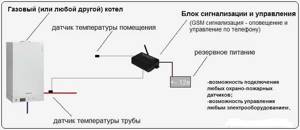
This is facilitated by the development of the production of such systems by Russian and foreign companies, as well as the increasing number of boilers on which such a device can be installed.
Advantages of the module
The main advantages of the device are:

- When using it, there is no need to maintain heat in a room where there are no people. The heating can be turned on, for example, by sending an SMS an hour before arriving at the house.
- The ability to always control the temperature in the room, leaving the boiler to operate in autonomous mode and without fear of an accident. Indeed, in this case, the GSM module will immediately inform the owner about all problems.
- Receive a warning about equipment shutdown as a result of a power outage. Knowing about the situation that has occurred, the user can take measures to correct it and eliminate the negative consequences that could result from stopping the heating system.
Disadvantages of the system
Naturally, when choosing such a device for your home, you should also know about its disadvantages. There is only one main drawback - the high cost of the entire complex, with the help of which the system is remotely controlled. Therefore, when purchasing a GSM controller, it is worth considering whether it is really needed in your home, or whether the system can be replaced with conventional automation that copes with all problems without human help.

Sometimes a problem with using the device may arise when the owner travels, for example, abroad. In this case, system messages may simply not reach the recipient. And using roaming will not be very beneficial for simply informing via SMS about the operation of the boiler.
How smart heating works
The heating system of an apartment or country house includes not only radiators, but also various types of convectors, heated floors, and heated towel rails. Recently, the option of warm walls that heat the air in the room in winter and cool it in summer has become popular.
This entire set, and in a country house, devices responsible in one way or another for heating, can be controlled separately or in combination.
The control system can be a single computer unit that controls appliances in the house and temperature sensors in rooms and outside.
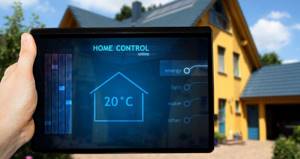
The system analyzes the sensor readings, and if the temperature differs from that set in the program, it gives a command to work. The temperature regime comfortable for staying in the house is set individually by the owner.
Smart heating can be economical, but subject to a number of conditions. So, the temperature in the house is affected not only by the weather outside the window, but also by other factors that influence the climate in the house, namely:
- thermal conductivity of walls and ceilings;
- quality of windows installed in the house;
- quality and sufficient protection of the front door;
- heat supply method;
- type of heating system in the house;
- the presence of dampness, drafts, and so on.
And even the smartest system will not work with proper efficiency if the causes leading to heat loss are not eliminated to the maximum. If the walls are not sufficiently protected, the system will heat the air, and you will lose the money spent on its operation.
Of course, in this case, the comfortable temperature you set will be maintained, but it will require more energy to complete the task.
How is smart heating controlled?
It all depends on whether you buy a ready-made system, or try to implement it yourself.
It is possible to create a smart heating system in your home yourself, but it involves a lot of nuances. Controllers can be installed on each device and heating unit, which will be connected to temperature sensors in the house.
Next, you set the required temperature and the option when the device stops working: upon reaching a certain air temperature, or at the time of switching on and off.
Implementing the system in this way has a number of significant drawbacks: the devices installed in the house are configured separately and are not connected to each other, that is, they will not be able to “agree” on their work. Moreover, the devices installed in the house will not respond to cold weather outside the window, since they will not receive information about it.

Centralized control of smart heating is also possible. Devices are controlled remotely using a single system, with each group of devices given its own settings.
Such a system works as a complex and does not require individual configuration of each individual device. Due to the fact that all devices in the system communicate information to each other, they are able to work together, which makes it possible to solve the task of achieving a comfortable temperature more efficiently and economically.
Again, purchasing a ready-made smart heating package with a particular task is much easier than doing it yourself.
In order for the heating process to be more efficient, a rational solution would be to distribute the area of the house into specific temperature zones and set the operating program for the appliances for them.
Let's say the living area will receive heat more actively, the garage, corridor or vestibule will be heated with less intensity. This is another way to reduce system operating costs.
An important condition for the effective operation of the system is the presence of temperature sensors not only inside the house, but also outside it. Due to the fact that the heating system can correlate the temperature inside and outside, it can set the optimal operating rate independently, without intervention from the owner.
